Although the UK has seen widespread sustained recovery for the large part in the retail industry since the end of the recession, the ongoing issues surrounding the Euro have meant Ireland has lagged somewhat behind. This has seen vacancy rates in all but three of the country’s urban centres climb, causing a degree of concern amongst industry experts.

According to commercial property consultancy CBRE, the past six months have seen vacancy rates rise in all areas other than Dublin, Athlone and Galway. In fact, Dublin’s recovery has reached the point where landlords have felt confident in increasing rents, although this trend is yet to reach Galway and Athlone where vacancy rates have remained stable and fallen respectively.
Grafton Street remains Ireland’s most popular destination for expanding international retail chains, with the result that the vacancy rate in this prime area now stands at just 3.2 per cent. As a result, prime Zone A rents have risen to €4,500 per square metre per annum – Dundrum Town Centre has followed suit by lifting rents to €4,000 per square metre per annum.
Senior director of retail at CBRE Ireland, Simon Cooper, believes that the proposed tax on vacant retail units currently being considered by the Government would compound the problem for areas struggling to attract retail tenants.
He says; “Interest in the Irish retail sector has certainly increased over the last number of months, with more international retailers continuing to circle the few retail properties that are available in prime locations.
“However, this trend has not yet filtered down to regional locations or those with continued high vacancy levels, where owners of retail properties are struggling to attract occupiers.
“This is why we would find it hard to believe that the Government are proposing planning policy changes which would see the introduction of a tax being imposed on these owners of vacant retail premises.”
At present, Limerick continues to boast the highest retail vacancy rate in the country, with the current 18.6 per cent rate a 2.3 per cent increase on six months ago. Cork follows closely behind with an 18.2 per cent vacancy rate then Sligo with 17.5 per cent; the latter, however, has seen vacancy rates rise by 5 per cent in the past six months, indicating that it may soon overtake Cork.
At the other end of the scale, Galway holds Ireland’s lowest retail vacancy rate at just 2.8 per cent, followed by Killarney, Dublin and Kilkenny on 2.9 per cent, 5.8 per cent and 6.6 per cent. Athlone has a vacancy rate of 15.9 per cent, but experienced the greatest improvement in the past six months with a 6 per cent decrease in vacant shop units.
With economic recovery slowly but surely progressing throughout the Eurozone at present, it can only be hoped that Ireland’s retail industry will not have to wait too long to reap the benefits of increased consumer spending felt here in the UK.
Why do you think Irish regional areas remain under the radar of retail chains?